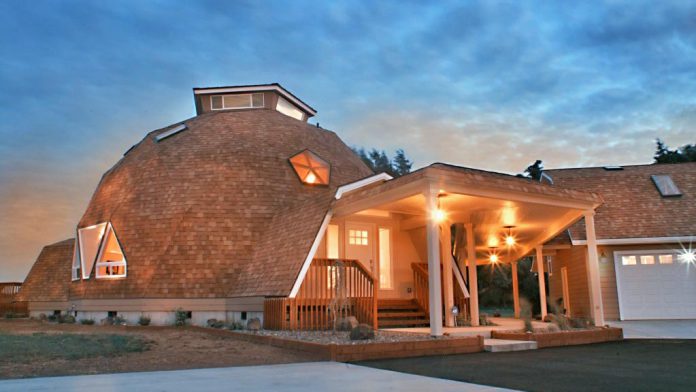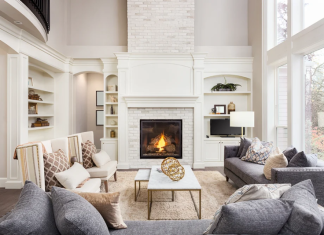A Geodesic is often an arc between two points on a surface, or generally in a Riemannian manifold. They keep temperatures even throughout the structure and advance more efficient air circulation. They insulate very efficiently due to their unique shape and make them more energy-efficient than normal conventional homes. They are a hemispherical thin-shell structure, geodesic polyhedron based. The triangular elements of the dome are rigid structurally and throughout the structure, they distribute the structural stress making a geodesic dome home possess the ability to withstand very heavy loads for its size.
The first dome to be considered as geodesic was designed by Walter Bars Feld and it was to accommodate a planetarium projector. This design was conducted at the Zeiss factory roof by Wydmann & Dykerhoff in Germany in 1922. Almost 30 years later, in 1954, Buckminster Fuller1, an American geological materialist proposed the seemingly independent idea of the domes and named them “Geodesic Dome”. In many books, he is referred to as the inventor of the geodesic dome. He first designed a dome, 17 meters high, for DOD at elevations that its wind speed reaches 360 kilometres per second.
These structures are made of bio ceramic, a self-adhesive material that is made largely out of phosphate recycled from wastewater. Geodesic dome homes are gaining more popularity among homebuyers in search of unique structures that can stand natural disasters and harsh weather conditions. People turn to these structures due to the fact they are more cost-effective and energy-efficient than the normal conventional square-shaped homes.
The advantages of these structures are:
1. Extremely Energy Efficient
They keep temperatures even throughout the structure and more efficient air circulation. This makes them two to four times more energy-efficient than normal conventional homes. These homes are very efficient in insulation due to their unique shapes. Since light refracts and stays inside the dome, these structures utilize solar energy reducing the need for artificial lighting. The younger generation of buyers who want more energy-efficient homes chooses the dome homes instead of the common conventional square-shaped homes.
2. Resistance to Natural Elements
The dome shapes are a very efficient surface for shedding elements such as snow and wind. There is evidence that these dome structures can withstand hurricane-force winds. Geodesic domes are particularly resistant to these types of forces because of their fewer flat surfaces that allow wind to move around the home. In addition to resisting powerful winds, domed homes can hold up better to mighty earthquakes.
3. They are Very Strong.
From a clarified engineering perspective, geodesic domes are cavalier to square homes. They are the only artificial structures that can get proportionally stronger as their size increases. They are more structurally sound, lighter, and require fewer materials as compared to the normal-shaped conventional homes.
4. Highly Fire Resistant
Comprising bio-ceramic, geodesic domes are considered highly fire-resistant. They are highly fireproof up to 2200 degrees F. This was influenced by the wildfires that hit the West coast.
5. Watertight Design
With the zonohedron design, most domes created have a lapped connection between the panels that when paired with rubber seals, make them water-resistant.
6. Pest, Mold, and Rot-resistant
These dome homes were designed with the idea of a five-hundred-year lifespan in mind, so the use of rigid and long-lasting material was necessary. Natural ceramic is a neutral composite that makes the structures immune to insects and other pests entirely and they never rot. This was the perfect material for the building and construction of geodesic dome homes.
7. Corrosion Resistance
They hardly or rather never corrode.
8. Ability to Run in Different Colors
They can work with any desired colors as compared to normal conventional design.
Ability to remove and reinstall. You can remove or move parts of the dome and reinstall them whenever you wish to make any changes to your dome.
9. The Speed and Accuracy because of Factory-made Parts
The speed and accuracy of building and construction of domes are made easier and more effective because of the standard sizes of the parts to be used made at the factories.
10. They are Cost-effective.
Geodesic dome homes lower your utility bills, and they save money in materials as well. The shape of a dome home means far less surface area than a typical conventional home and does not require so many materials to build it hence the cost savings commence during construction and continue throughout the life of the home.
Despite the advantages of geodesic dome homes, here are some of the things to consider.
i) When it comes to the construction of a geodesic home, builders expect to confront some challenges. Chimneys can be practically hard to place and if it is a larger home, fire escapes can be very expensive to install.
ii) It can also be very difficult to create rooms or create divisions within the dome structures especially when you do not have a lot of experience in building them.
iii) Since the normal conventional home is a square shape, fixtures, utilities, and basic appliances are manufactured for right angles so if you are not used to building these types of homes, it can be hard to find off-the-shelf materials that fit the home.
iv) Areas regularly affected by hurricanes and tornadoes, modern homeowners are turning to geodesic dome homes at an increasing rate because they hold up better to storms and high winds. Due to the shift in construction needs, the utility options and interior design for geodesic dome homes have increased substantially hence takes a knowledgeable builder.
v) Domes are more difficult and complicated to the roof and it takes way much longer time to roof than a normal conventional house because if not properly installed, they leak like a sieve.
Conclusion
These spheres use the “doing more with less” principle in that they enclose the largest volume of interior space with the least amount of surface area, therefore, saving on cost and materials. Therefore, the most efficient interior atmosphere for the human dwelling is the spherical structure of the dome because air and energy can circulate without obstruction and makes it possible for cooling and heating to occur naturally. All around the world these geodesic shelters have been built in different climates and temperatures and they have proven to be the most efficient for human shelters.















